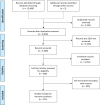Factors associated with accessing and utilisation of healthcare and provision of health services for residents of slums in low and middle-income countries: a scoping review of recent literature
- PMID: 35613790
- PMCID: PMC9125718
- DOI: 10.1136/bmjopen-2021-055415
Factors associated with accessing and utilisation of healthcare and provision of health services for residents of slums in low and middle-income countries: a scoping review of recent literature
Abstract
Objective: To identify factors associated with accessing and utilisation of healthcare and provision of health services in slums.
Design: A scoping review incorporating a conceptual framework for configuring reported factors.
Data sources: MEDLINE, Embase, CINAHL, Web of Science and the Cochrane Library were searched from their inception to December 2021 using slum-related terms.
Eligibility criteria: Empirical studies of all designs reporting relevant factors in slums in low and middle-income countries.
Data extraction and synthesis: Studies were categorised and data were charted according to a preliminary conceptual framework refined by emerging findings. Results were tabulated and narratively summarised.
Results: Of the 15 469 records retrieved from all years, 4368 records dated between 2016 and 2021 were screened by two independent reviewers and 111 studies were included. The majority (63 studies, 57%) were conducted in Asia, predominantly in India. In total, 104 studies examined healthcare access and utilisation from slum residents' perspective while only 10 studies explored provision of health services from providers/planners' perspective (three studies included both). A multitude of factors are associated with accessing, using and providing healthcare in slums, including recent migration to slums; knowledge, perception and past experience of illness, healthcare needs and health services; financial constraint and competing priorities between health and making a living; lacking social support; unfavourable physical environment and locality; sociocultural expectations and stigma; lack of official recognition; and existing problems in the health system.
Conclusion: The scoping review identified a significant body of recent literature reporting factors associated with accessing, utilisation and provision of healthcare services in slums. We classified the diverse factors under seven broad categories. The findings can inform a holistic approach to improving health services in slums by tackling barriers at different levels, taking into account local context and geospatial features of individual slums. SYSTEMATIC REVIEW REGISTRATION NUMBER: https://osf.io/694t2.
Keywords: health services administration & management; international health services; public health.
© Author(s) (or their employer(s)) 2022. Re-use permitted under CC BY. Published by BMJ.
Conflict of interest statement
Competing interests: None declared.
Figures



References
-
- United Nations . The sustainable development goals report, 2019.
-
- Kosamkar A. Problems in urban society. EPRA Int J Multidiscip Res 2020;6.
Publication types
MeSH terms
Grants and funding
LinkOut - more resources
Full Text Sources
Miscellaneous
